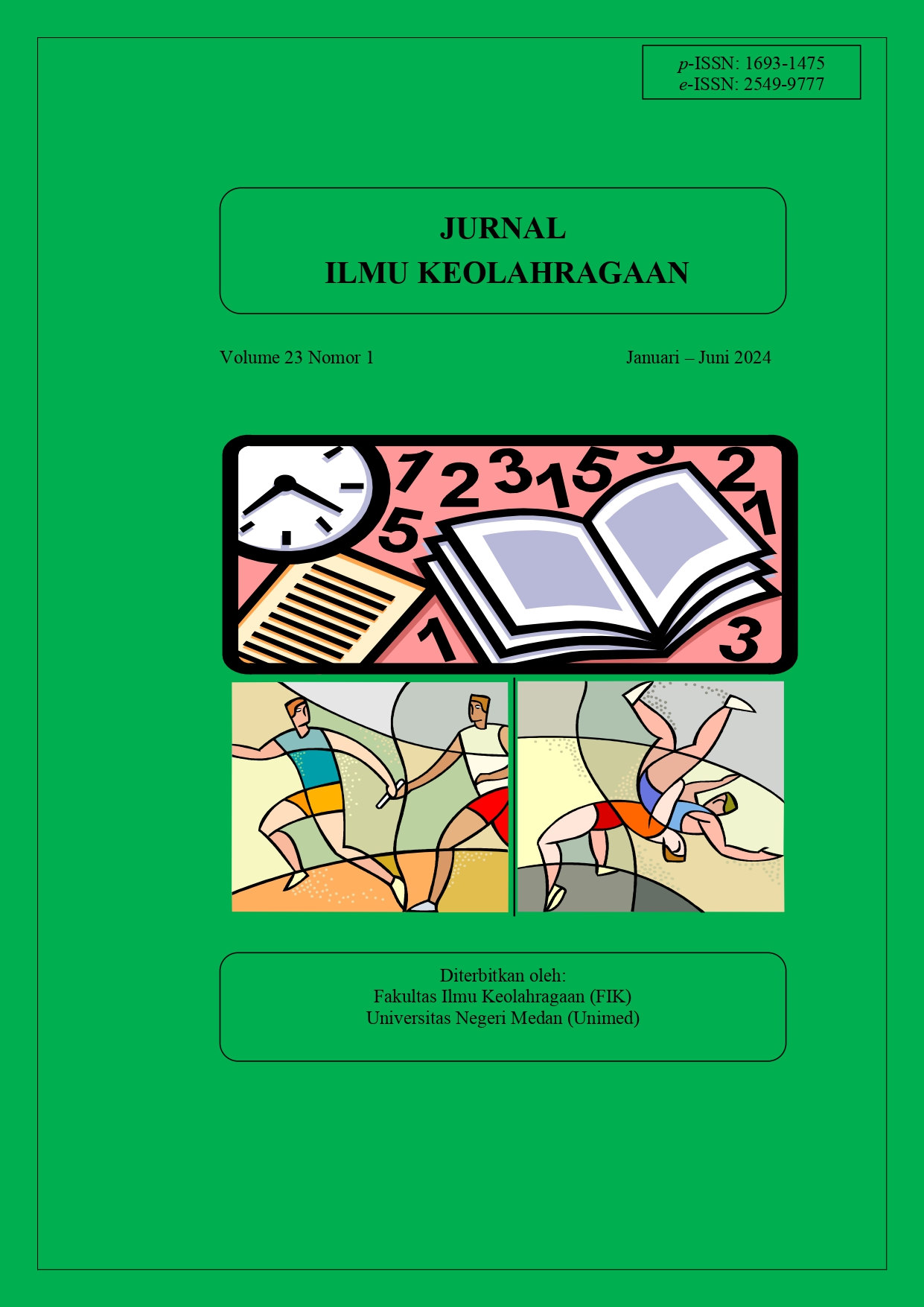PENGARUH DUKUNGAN SOSIAL DAN SELF EFFICACY TERHADAP PERILAKU AKTIVITAS FISIK MAHASISWA
DOI:
https://doi.org/10.24114/jik.v23i1.57247Keywords:
Social support, Self efficacy, Physical activityAbstract
This research aims to determine the influence of social support and self-efficacy on students' physical activity behavior. The design used in this research is correlational with random sampling techniques. The total sample from this research was 70 respondents from sports science students in 2022. The instruments used in this research were the Social Support Exercise Survey questionnaire, the Exercise Self-Efficacy Scale, and the International Physical Activity Questionnaire. After that, the results of the research data were analyzed using multiple linear analysis parametric tests with the IBM SPSS version 25 application because the data was normally distributed. The results of the analysis show that there is family influence on students' physical activity with a value of Sig. < 0.05 and t value > 1.998, for the influence of friend support there is no influence on students' physical activity with a value of Sig. > 0.05 and the calculated t value < 1.998, for the influence of self-efficacy there is an influence on students' physical activity with a Sig value. < 0.05 and tcount > 1.998.References
Chaput, J. P., Gray, C. E., Poitras, V. J., Carson, V., Gruber, R., Olds, T., ¦ Tremblay, M. S. (2016). Systematic review of the relationships between sleep duration and health indicators in school-aged children and youth. Applied Physiology, Nutrition and Metabolism, 41(6), S266“S282. https://doi.org/10.1139/apnm-2015-0627
Chen, H., Sun, H., & Dai, J. (2017). Peer support and adolescents™ physical activity: The mediating roles of self-efficacy and enjoyment. Journal of Pediatric Psychology, 42(5), 569“577. https://doi.org/10.1093/jpepsy/jsw103
Ghorbani, S., Afshari, M., Eckelt, M., Dana, A., & Bund, A. (2021). Associations between physical activity and mental health in Iranian adolescents during the COVID-19 pandemic: An accelerometer-based study. Children, 8(11). https://doi.org/10.3390/children8111022
Kathleen, A. M., Kudrat, J., & Arya, J. (2022). The psychological status of resident doctors during the COVID‘19 pandemic and its association with resilience and social support: A cross‘sectional study. Indian Journal of Health Sciences and Biomedical Research (KLEU), 15(1), 12“19. https://doi.org/10.4103/kleuhsj.kleuhsj
R.K., D., R.P., S., R.W., M., M., D., & R.R., P. (2009). Self-efficacy moderates the relation between declines in physical activity and perceived social support in high school girls.Chaput, J. P., Gray, C. E., Poitras, V. J., Carson, V., Gruber, R., Olds, T., ¦ Tremblay, M. S. (2016). Systematic review of the relationships between sleep duration and health indicators in school-aged children and youth. Applied Physiology, Nutrition and Metabolism, 41(6), S266“S282. https://doi.org/10.1139/apnm-2015-0627
Chen, H., Sun, H., & Dai, J. (2017). Peer support and adolescents™ physical activity: The mediating roles of self-efficacy and enjoyment. Journal of Pediatric Psychology, 42(5), 569“577. https://doi.org/10.1093/jpepsy/jsw103
Ghorbani, S., Afshari, M., Eckelt, M., Dana, A., & Bund, A. (2021). Associations between physical activity and mental health in Iranian adolescents during the COVID-19 pandemic: An accelerometer-based study. Children, 8(11). https://doi.org/10.3390/children8111022
Kathleen, A. M., Kudrat, J., & Arya, J. (2022). The psychological status of resident doctors during the COVID‘19 pandemic and its association with resilience and social support: A cross‘sectional study. Indian Journal of Health Sciences and Biomedical Research (KLEU), 15(1), 12“19. https://doi.org/10.4103/kleuhsj.kleuhsj
R.K., D., R.P., S., R.W., M., M., D., & R.R., P. (2009). Self-efficacy moderates the relation between declines in physical activity and perceived social support in high school girls. Journal of Pediatric Psychology, 34(4), 441“451. Retrieved from http://ovidsp.ovid.com/ovidweb.cgi?T=JS&PAGE=reference&D=emed9&NEWS=N&AN=2009205936
Sheikh, M., Bay, N., Ghorbani, S., & Esfahaninia, A. (2022). Effects of Social Support and Physical Self-efficacy on Physical Activity of Adolescents. International Journal of Pediatrics, 10(100), 15823“15834. https://doi.org/10.22038/IJP.2022.62762.4793
Short, C. E., Vandelanotte, C., & Duncan, M. J. (2014). Individual characteristics associated with physical activity intervention delivery mode preferences among adults. International Journal of Behavioral Nutrition and Physical Activity, 11(1), 1“10. https://doi.org/10.1186/1479-5868-11-25
Sun, R. T., Han, W., Chang, H. L., & Shaw, M. J. (2021). Motivating adherence to exercise plans through a personalized mobile health app: Enhanced action design research approach. JMIR MHealth and UHealth, 9(6). https://doi.org/10.2196/19941
Whooten, R., Kerem, L., & Stanley, T. (2019). Physical activity in adolescents and children and relationship to metabolic health. Current Opinion in Endocrinology, Diabetes and Obesity, 26(1), 25“31. https://doi.org/10.1097/MED.0000000000000455
Wibowo, R. A., Kelly, P., & Baker, G. (2020). The effect of smartphone application interventions on physical activity level among university/college students: a systematic review protocol. Physical Therapy Reviews, 25(2), 135“142. https://doi.org/10.1080/10833196.2020.1756125
Zara, M. C., & Monteiro, L. H. A. (2021). The negative impact of technological advancements on mental health: An epidemiological approach. Applied Mathematics and Computation, 396, 125905. https://doi.org/10.1016/j.amc.2020.125905
Zhang, Y., Hasibagen, & Zhang, C. (2022). The influence of social support on the physical exercise behavior of college students: The mediating role of self-efficacy. Frontiers in Psychology, 13(December), 1“10. https://doi.org/10.3389/fpsyg.2022.1037518

